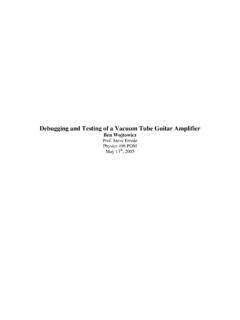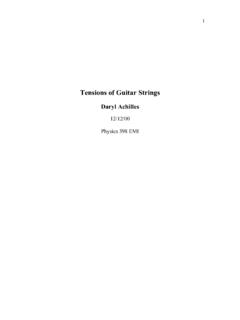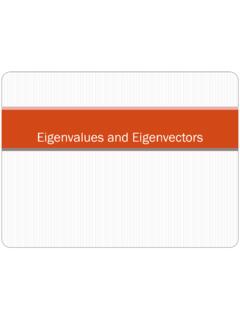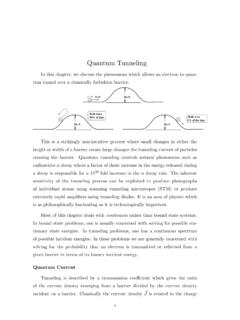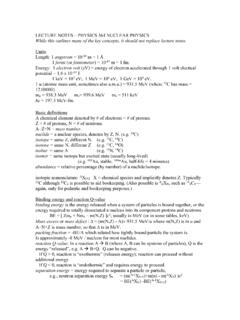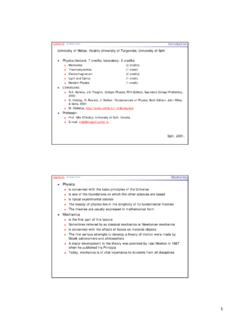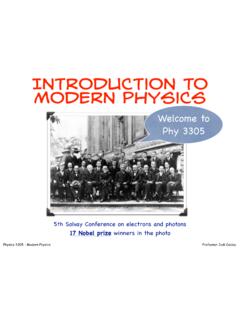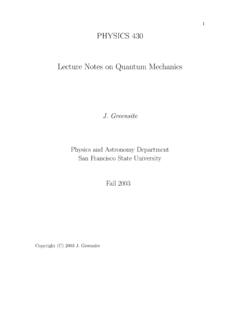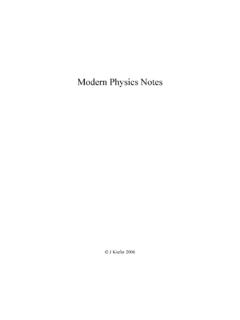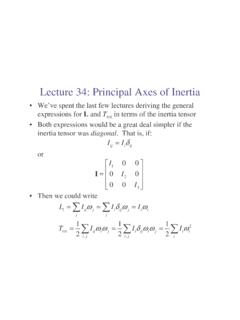Transcription of Physics 212 Lecture 11 - University of Illinois Urbana ...
1 Physics 212 Lecture 11 Today s Concept: RC Circuits Electricity & Magnetism Lecture 11, Slide 1 Your Comments Electricity & Magnetism Lecture 11, Slide 2 The moment I saw Kirchhoff's Rule for charging a capacitor and a resistor was a first order forced differential equation, I got really excited. I just pretty much failed my test and it is my major after doing good on the quizzes and homework and then you throw this at me and I don' know what is happening. I can kiss my A good bye. Holly Hell!!! First, please go over EVERYTHING TOMOROW!!! Secondly, why is the University letting us take this course without having done intro to differential equations yet!
2 !! So let's strip these equations down to more intuitive forms. Hi Mom! Hi professor stelzer, could we please have a grade estimator so i can calculate my grade in this class. I didn t do too well on exam 1 and i am freaking out. I know that a lot of times in prelecture there are extra things told to us to help us get a better understanding (which is very good) but in this prelecture, I couldn't really tell what all we actually had to be responsible for exactly. This Lecture was pretty straight forward. Hopefully we won't have to memorize these equations because they're all complicated and they all look pretty similar.
3 Also, the two batteries and 6 resistors question from the last homework was pretty ridiculous. Hour Exam 1 Results Electricity & Magnetism Lecture 11, Slide 3 Average score 72% Check under course description for grading policy ( if you got a 60% on this exam, then you missed 40/1000 course points. That does not mean you will get a D in the course! But, that you should have a strategy to do better on the remaining exams.) The 212 Differential Equations We describe the world (electrical circuits, problems in heat transfer, control systems, financial markets, etc.) using differential equations You only need to know the solutions of two basic differential equations Physics 212 Lecture 11, Slide 5 /10tconstdqqqqedt 2220sinconstdqqqqtdtCapacitors in RC Circuits Solve by applying Kirchhoff s Rules to circuit.
4 Need to understand some key phrases. IMMEDIATELY After === Charge on capacitor is same as immediately before After a LONG TIME === Current through capacitor = 0 After xx seconds === Exponentially more difficult! Electricity & Magnetism Lecture 11, Slide 6 RC Circuit (Charging) Kirchoff s Voltage Rule Short Term (q q0 0) Long Term (Ic 0) R Vbattery C a b Intermediate a R Vbattery C b Capacitor uncharged, Switch is moved to position a Electricity & Magnetism Lecture 11, Slide 7 0 IRCqVbattery000 RIVbatteryRVIbattery 000 RCqVbatterybatteryCVq 0 RdtdqCqVbattery RCteqtq/1)( RCteIdtdqtI/0)( CheckPoint 1 Close S1, V1 voltage across C immediately after V2 voltage across C a long time after A) V1 V V2 V B) V1 0 V2 V C) V1 0 V2 0 D)
5 V1 V V2 0 Immediately after the switch S1 is closed: Q is same as immediately before After the switch S1 has been closed for a long time IC 0 Electricity & Magnetism Lecture 11, Slide 9 A circuit is wired up as shown below. The capacitor is initially uncharged and switches S1 and S2 are initially open. V 2R C R S1 S2 Close S1 at t = 0 (leave S2 open) At t big V C R I 0 VC V At t 0 V C R I VC Qinitial/C 0 Electricity & Magnetism Lecture 11, Slide 10 CheckPoint 1 Close S1, V1 voltage across C immediately after V2 voltage across C a long time after A) V1 V V2 V B) V1 0 V2 V C) V1 0 V2 0 D) V1 V V2 0 Electricity & Magnetism Lecture 11, Slide 11 A circuit is wired up as shown below.
6 The capacitor is initially uncharged and switches S1 and S2 are initially open. Immediately after the switch S1 is closed: Q is same as immediately before After the switch S1 has been closed for a long time IC 0 Kirchoff s Voltage Rule Short Term (q q0) Long Term (Ic 0) RC Circuit (Discharging) R Vbattery C a b Intermediate V Capacitor has q0 CVbattery, Switch is moved to position b R Vbattery C a b I I Electricity & Magnetism Lecture 11, Slide 12 0 IRCq0 IRVbatteryRVIbattery 000 RCq0 q0 RdtdqCqRCteqtq/0)( RCteItI/0)( V 2R C V I IR CheckPoint 1c Electricity & Magnetism Lecture 11, Slide 13 A circuit is wired up as shown below.
7 The capacitor is initially uncharged and switches S1 and S2 are initially open. After being closed a long time, switch 1 is opened and switch 2 is closed. What is the current through the right resistor immediately after switch 2 is closed? A. IR = 0 B. IR = V/3R C. IR = V/2R D. IR = V/R CheckPoint 1 d Electricity & Magnetism Lecture 11, Slide 15 A circuit is wired up as shown below. The capacitor is initially uncharged and switches S1 and S2 are initially open. Now suppose both switches are closed. What is the voltage across the capacitor after a very long time? A. VC = 0 B. VC = V C. VC = 2V/3 A) The capacitor would discharge completely as t approaches infinity B) The capacitor will become fully charged after a long time.
8 C) Current through capacitor is zero 2R C R S1 S2 Close both S1 and S2 and wait a long V 2R C R V I IR 2IR -V 0 I V/(3R) No current flows through the capacitor after a long time. This will always be the case in any static circuit!! VC VC (2/3)V Electricity & Magnetism Lecture 11, Slide 16 Outer Loop +VC - 2IR 0 VC=2IR Right Loop CheckPoint 1 d Electricity & Magnetism Lecture 11, Slide 17 A circuit is wired up as shown below. The capacitor is initially uncharged and switches S1 and S2 are initially open. Now suppose both switches are closed. What is the voltage across the capacitor after a very long time?
9 A. VC = 0 B. VC = V C. VC = 2V/3 a) The capacitor would discharge completely as t approaches infinity b) The capacitor will become fully charged after a long time. c) Current through capacitor is zero What will happen after I close the switch? A) Both bulbs come on and stay on. B) Both bulbs come on but then bulb 2 fades out. C) Both bulbs come on but then bulb 1 fades out. D) Both bulbs come on and then both fade out. No initial charge on capacitor No final current through capacitor V(bulb 2) 0 Both bulbs light V(bulb 1) V(bulb 2) V V C S Bulb 1 Bulb 2 R R DEMO Clicker Question 1 Electricity & Magnetism Lecture 11, Slide 18 Suppose the switch has been closed a long time.
10 Now what will happen after open the switch? A) Both bulbs come on and stay on. B) Both bulbs come on but then bulb 2 fades out. C) Both bulbs come on but then bulb 1 fades out. D) Both bulbs come on and then both fade out. Capacitor has charge ( CV) V C S Bulb 1 Bulb 2 R R DEMO Clicker Question 2 Electricity & Magnetism Lecture 11, Slide 19 Capacitor discharges through both resistors In this circuit, assume V, C, and Ri are known. C initially uncharged and then switch S is closed. What is the voltage across the capacitor after a long time ? Conceptual Analysis: Circuit behavior described by Kirchhoff s Rules: KVR: S Vdrops 0 KCR: S Iin S Iout S closed and C charges to some voltage with some time constant Strategic Analysis Determine currents and voltages in circuit a long time after S closed V R1 R2 C R3 S Calculation Electricity & Magnetism Lecture 11, Slide 20 V R1 R2 C R3 S Immediately after S is closed: what is I2, the current through C what is VC, the voltage across C?


